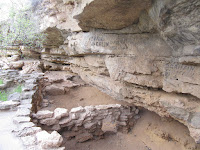 Today we hit the 3 distinct campuses of Montezuma Castle
National Monument, designated by Teddy Roosevelt in 1906, and Tuzigoot National
Monument, designated by distant relative Franklin in 1939.
Today we hit the 3 distinct campuses of Montezuma Castle
National Monument, designated by Teddy Roosevelt in 1906, and Tuzigoot National
Monument, designated by distant relative Franklin in 1939. Both monuments display ruins from what generally is referred
to as the Sinaguan Culture dating from between 1.100 and 1,300 AD. Montezuma’s
Castle is a mammoth 5 story cliff dwelling nestled along the Beaver Creek.
Archeologists believe the Sinagua farmed the area, using the Beaver Creek as
their primary water source.
Both monuments display ruins from what generally is referred
to as the Sinaguan Culture dating from between 1.100 and 1,300 AD. Montezuma’s
Castle is a mammoth 5 story cliff dwelling nestled along the Beaver Creek.
Archeologists believe the Sinagua farmed the area, using the Beaver Creek as
their primary water source. Not far from the Castle is Montezuma Well. Cliff dwelling
ruins also circle this body of water which is a rare geological formation. A
deep sinkhole formed above a spring, and the spring water filled the sink hole
with many thousand gallons of fresh water. Each day about 10% of the water is
replaced – the amount that seeps out making new for the fresh. As a result,
this made an ideal location for the ancients.
Not far from the Castle is Montezuma Well. Cliff dwelling
ruins also circle this body of water which is a rare geological formation. A
deep sinkhole formed above a spring, and the spring water filled the sink hole
with many thousand gallons of fresh water. Each day about 10% of the water is
replaced – the amount that seeps out making new for the fresh. As a result,
this made an ideal location for the ancients. The water that seeped out of Montezuma’s Well was not wasted
either. The Sinagua built irrigation ditches that channeled the escaping water
to their fields. The 1,600-year-old ditches still remain in many places, one of
which is the base of Montezuma’s Well.
The water that seeped out of Montezuma’s Well was not wasted
either. The Sinagua built irrigation ditches that channeled the escaping water
to their fields. The 1,600-year-old ditches still remain in many places, one of
which is the base of Montezuma’s Well. Tuzigoot is not a cliff dwelling. Much like Anasazi ruins we
have seen in New Mexico, Tuzigoot is an above ground pueblo community built on
top of a hill (for defensive reasons) not far from the Tuzigoot River (for
needed water).
Tuzigoot is not a cliff dwelling. Much like Anasazi ruins we
have seen in New Mexico, Tuzigoot is an above ground pueblo community built on
top of a hill (for defensive reasons) not far from the Tuzigoot River (for
needed water).  Most of the remains were actually reconstructed by
well-meaning archeologists in the 1930’s. I say well-meaning in that what they
did was take stone and reconstruct what they imagined the structures likely
looked like. Today, the National Park Service leaves such historical ruins in a
state of arrested decay in order not to inadvertently change the sites into
something that they might not have been. Luckily, some of the original walls
still exist at Tuzigoot.
Most of the remains were actually reconstructed by
well-meaning archeologists in the 1930’s. I say well-meaning in that what they
did was take stone and reconstruct what they imagined the structures likely
looked like. Today, the National Park Service leaves such historical ruins in a
state of arrested decay in order not to inadvertently change the sites into
something that they might not have been. Luckily, some of the original walls
still exist at Tuzigoot.
Talk to you soon!
No comments:
Post a Comment